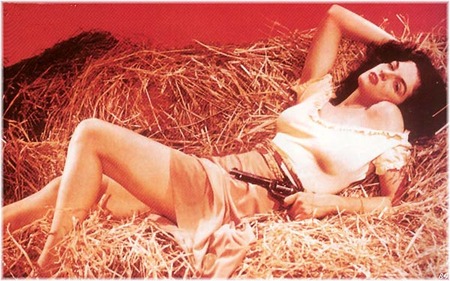 Jane Russell could never be a star today, and more’s the pity. Though her start was shaky, and she was of limited range, Russell had a certain ironic detachment that made her a delight to watch. She knew why she became a star and why people liked her. It was simple: Jane Russell (born Ernestine Jane Geraldine Russell) had big tits.
Jane Russell could never be a star today, and more’s the pity. Though her start was shaky, and she was of limited range, Russell had a certain ironic detachment that made her a delight to watch. She knew why she became a star and why people liked her. It was simple: Jane Russell (born Ernestine Jane Geraldine Russell) had big tits.
Howard Hughes – partly a boob man, but more than anything a capitalist – saw something he could make famous: large breasts on a small frame. In a time when pornography was a crime, and the best that could be found were soundless one-reelers (that history has taught us were mostly viewed at Elk’s club), and the Hays code restricting any film that suggested the romantic leads were going to do something about it, Russell’s physique could do what less endowed women like Greta Garbo, Marlene Dietrich or Veronica Lake had to act to sell and might be censored for. Russell – with her ridiculous cleavage – was walking sex. Hughes knew it, and designed bras and outfits to highlight her mammaries. As The Aviator attests, he had to fight tooth and nail for each blessed millimeter of skin he could.
His film (originally started by Howard Hawks) The Outlaw was a western that had characters called Billy The Kid, Pat Garrett, and Doc Holiday, but no one talks about the film for its melding and commentary on Western legends. What they talk about is the image above. Russell – dress off the shoulder, bra-less (or with non-period bra technology), cradling a gun in her hands (symbolism) as her legs are lightly askew, laying in the hay looking like she just got fucked by someone with evident skill, though perhaps not entirely sated – could do more by being more where it counted. The Hays code saw red, Hughes saw green, and boys became men (and men became wolves).
It’s also true that this above image is more famous than the film itself. Considering it has a script by the always dependable Jules Furthman (with uncredited work from Hawks and Ben Hecht), the movie itself is a mishmash, and Hughes was a modest director. It was made in 1941, got a limited theatrical showing in 1943 for a week, and then finally went into general release in 1946 – the censorship struggles went on that long – to become a smash hit. Even so there were still regional censors, which is why the film has run from its current “full” 115 minute version to as short as 95 minutes (some of which had to have been happy projectionists taking home souvenirs). There are a lot of things to like about the film, but it’s no great work – like Veronica Lake, Jane Russell is more famous for being an image than star. Russell trained to be an actress, but she got better with age and was always best with directors who knew how to use her.
When a director had her number she showed that she could hold her own. Paired with Bob Hope in the two Paleface movies, she was a proficient straight-man, and was a perfect foil with her amazon frame an appealing comic contrast to Hope’s cowardly gun-slinger. Frank Tashlin took over for the sequel and did her right (and also prepared himself for The Girl Can’t Help It). One of my favorites is the delightfully weird Macao, which partnered her with Robert Mitchum under the eyes of director Joseph Von Sternberg (though the film has three uncredited directors, including Nicholas Ray). Regardless of who the auteur is – though it’s a gorgeous film – Russell gets to sing (she was okay, pretty good), and do what she did best: Sarcasm. Never lost on Russell was why she became famous, and that sense of annoyance at being just eye candy came out. It seemed to bore her that men viewed her as a lust object, and it only added to her charm.
And if such is why she’s fondly remembered, Howard Hawks (her first director) easily gave her the best on-screen role she’d ever have, and saw the genius of pairing her with equally bosomy Marilyn Monroe in Gentlemen Prefer Blondes. Monroe plays the dingbat, while Russell is the anchor. For my money I’ve always been a Russell man, partly because Hawks understands that being jaded and rude was part of her charm. She’d been around the block, and though she might still be at the bar at last call, she wasn’t going to suffer fools gladly even if she still might sleep with them. In that way I’ve always seen her as a model for the Marion Ravenwood character in Raiders of the Lost Ark. Howard Hawks is my favorite director (well, him or Jean Renoir), and Russell was playing the sort of woman that Hawks was in love with: the intelligent, sassy, a sexual aggressor. Lauren Bacall is the poster child of this type, but Russell did it as well as anyone.
Though she had some box office successes, Russell – like many of her type – moved into television, with some final and mostly uneventful big screen appearances in films like The Born Losers and Darker than Amber – the Travis McGee film. But by the 1980’s she was mostly courted by the occasional press, who always got great stories out of her. Russell’s films may have sold her short, but her image looms large over Hollywood. One could even say it heaves.